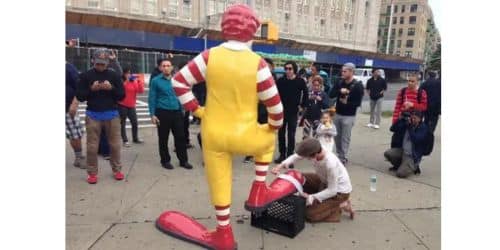A publicity stunt, also known as a PR stunt, can make or break a brand. While they have the potential to garner a slew of positive press, they can also easily turn sour. This year we’ve already seen our fair share of both, from the overwhelming success of Adidas’s 3D-printed statues of sportswomen and activists to the outrage over Grubhub’s New York City free lunch promo. However, since PR stunts need to be both carefully calculated and perfectly executed in order to make a lasting positive impression, it’s essential to guide clients along the way. Therefore, this article will explain a pr stunt, its examples, what makes it successful, and smile stunts in horror movies.
PR Stunt
A publicity stunt, or PR stunt, is a planned event that marketers and public relations specialists design to attract the public’s attention while garnering media coverage for a figure or brand. PR firms, performers, and public figures can professionally organize PR stunts to stand out from the rest. A PR or publicity stunt is a large and coordinated professional or amateur public relations event that is intended to raise awareness about a cause or product. Other publicity stunts may be done for fundraising. While the end result of publicity stunts is very public, the work that goes into them stays behind the scenes. This results in most people, including clients, assuming all it takes to pull off a successful stunt is a big idea.
It’s the PR professional’s job to point out what ideas will be valuable to the brand’s goals, and which will go nowhere. So if your clients want a publicity stunt, it’s up to you to ask the right questions to identify their goal and create a campaign that will achieve the desired impact. This post discusses different kinds of PR stunts, how to create a successful publicity stunt, and whether they work.
What Makes a Successful PR Stunt
These three factors determine whether or not a PR stunt is successful:
Community involvement: Having a few participants doesn’t automatically make a stunt a failure. However, it’s always best to have as many people as possible involved. The power of numbers can influence other would-be participants to join, raising the profile of the stunt.
Creators, then, should try to be exact about the exact number of people they are aiming for. For some stunts, one or two donors may be enough. For others, anything less than a big crowd means it’s a dud.
Be Memorable: While a stunt drawing a crowd can point to short-term success, it doesn’t necessarily indicate that the stunt is more successful than one that pulled, say, half the size. If the stunt that pulled in the smaller crowd is still being discussed several years later, that’s a better metric to use to measure its success.
Be bold: People remember publicity stunts that do something fun and unique. A good example is the ALS Ice Bucket Challenge, which was so bold that it influenced costume companies to create a Halloween costume based on it. Looking back even further, Snapple tried to create the world’s largest ice cream popsicle in 2005. While that objective wasn’t met on account of the popsicle melting, interest in the Snapple brand rose.
PR Stunt Examples
The mentioned examples of the pr stunt conducted by the most popular companies will allow you to comprehend the objectives, the significance, and the influence of such stunts on the public’s smile or frown.
#1. ALS Ice Bucket Challenge
In 2014, ALS held an Ice Bucket Challenge that saw people pour a bucket of ice water on themselves or others to promote awareness of ALS (amyotrophic lateral sclerosis) and raise money for its research. The stunt helped the ALS Association raise over $100 million for research due to celebrities’ participation, including then-president Barrack Obama.
#2. Tinder’s 2014 Adopt a Dog Campaign
In 2014, dating site Tinder launched a national “Swipe Right to Adopt a Dog” campaign during National Adopt a Shelter Pet Day. The stunt aimed at connecting ten dogs available for adoption with homes. It generated over 2,700 matches in one week and set the dating company apart from its competitors.
#3. The Greatest Showman
Two years ago, “The Greatest Showman” debuted in movie theaters all over the country. It’s based on the life of renowned showman, P.T. Barnum, also the founder of Barnum and Bailey Circus.
After founding the circus in 1871, Barnum began the pioneering of one of the most successful uses of PR to generate interest in his business. Barnum became an even more recognizable face through his PR stunts. One of the main ones was the use of an elephant to help clear his yard after a show.
His early adoption of PR comes with some criticism, as he’s widely regarded as having been dishonest, and even deceitful. Despite that, it’s obvious that he knew and used the power of free PR in the media.
#4. Justin Bieber and Tom Cruise
A few months ago, Justin Bieber sent out a tweet challenging Tom Cruise to a fight in the octagon. His reasons for taking the challenge were never fully explained. A few weeks after, he would go on to issue another challenge to the actor, this time opting for the bottle cap challenge as the competition.
While no explanation was given for this as well, the reason soon became clear when he released a new single, “Better With You.”
#5. Janelle Evans
Actress Janelle Evans appeared in the press and tabloids in a story about the killing of her dog by her estranged husband. Given that she has over 5 million followers on social media, some have speculated that this was an attempt to garner interest for her autobiography.
#6. McDonald’s
McDonald’s capitalized on simple but clever PR by turning its “M” upside down on International Women’s Day, as a show of support for women’s rights. The message was well received while being very low-cost for McDonald’s.
When trying to come up with ideas for a PR stunt, referring to some that have been successful in the past is a good starting point. The more recent they are, the greater the chance that they will appeal to today’s audience. In 2017 and 2018, there were some innovative creations in PR that can offer inspiration to companies looking to stage their own stunts. Here are some of them.
#7. Cancer Research
An interactive ad campaign by the Cancer Research charity in March of 2017 was both highly impressive and impactful. It was designed to help people all over the world smoke as they wait for the bus. To help people see how smoking affects their breathing, the advertising strategy placed posters in bus shelters that encouraged people to breathe in.
The longer someone would take to exhale, the more of the poster they would be able to see. Smokers didn’t have as easy a time blowing out, which caused smoking helplines to appear on the screen.
#8. Walkers Crisps
Walkers has built up a reputation for giving customers the choice of the kind of food they want to eat. The UK snack brand initiated a nationwide vote that allowed individuals to select new flavors in favor of older ones or save the old flavors.
The aim was to encourage people to try the new flavors they were offering or save their older offerings.
#9. KFC Christmas Campaign
In March 2017, KFC embraced the fun and carefree nature of its brand with a marketing stunt designed to encourage greater appreciation of its chicken. The KFC UK and Ireland brand designed a bland kale, cauliflower, and chicken burger. The idea, which worked, was to remind their customers of what they’d miss out on if they adopted the healthy eating craze.
#10. Elon Musk’s SpaceX Launch
When Elon Musk launched his car into space in a highly publicized stunt, it showed people all over the world how reliable and sustainable Tesla cars are. Following the launch, there was a significant uptick in interest in Tesla cars, along with sustained social media discussion.
#11. The IHOP Name Change
Controversy can, when used wisely and with caution, be an effective ingredient in staging a PR stunt that causes a stir. IHOP decided to launch its name change as a campaign that invited customers to guess what the reason for the change was.
When the company revealed that it was to match its emergence as the international house of burgers, many customers were left unhappy, and they voiced that through social media and other channels. Regardless, the stunt resulted in an increased discussion about the brand and media attention for IHOP.
Smile PR Stunt
On paper, Smile might seem like another run-of-the-mill horror movie a la Ma or The Black Phone. It doesn’t seem like a movie that will go down as a classic or keep you up at night, but it might give you a good scare or two when you are trying to go to the bathroom in the middle of the night and accidentally look at yourself in the mirror.
Director Parker Finn took the inherently silly premise of “Hey, what if smiling was actually scary?” and just ran with it, which is a very honorable thing to do. But the real magic of Smile, which hits theaters this Friday, is their A+ marketing team that thought “Hey, what if smiling while watching baseball was scary?” And it worked!
Why Is It Called PR Stunt?
There’s a reason why PR stunts are called “stunts”—it’s because that’s the idea behind them. Everything about them is meant to make people notice them. Many people who work in PR think that the bigger the press stunt, the better. As long as it’s big enough to make people talk about it, it’s done what it was meant to do.
Why Do PR Stunts?
A PR stunt is done to bring more attention to a business or person. A PR stunt doesn’t have to be a traditional marketing effort. It can take many different forms. The key is to be unique.
What Is PR Influencer?
The goal of influencer public relations is to coordinate the desired brand or behavior change with the efforts of the targeted influencer. You may learn more about the effectiveness of influencer marketing by reading about its measurement.
Do PR Stunts Work?
A well-executed publicity stunt, especially during a major event like the Super Bowl, can increase brand awareness and, in turn, sales for a company. A publicity stunt’s success hinges on its capacity to amaze and astound in equal measure.
Conclusion
Publicity stunts that work and ones that don’t show us the risks and growth possibilities of this type of marketing. In the 21st century, there is no such thing as black and white, and companies should be well-informed and ready to make the right choices before planning and carrying out a PR stunt. As shown by the examples of the best and worst publicity stunts of all time, publicity stunts should be done with care.
Reference
#1. Drum
#2. Fitsmallbusiness
#3. Uproxx






